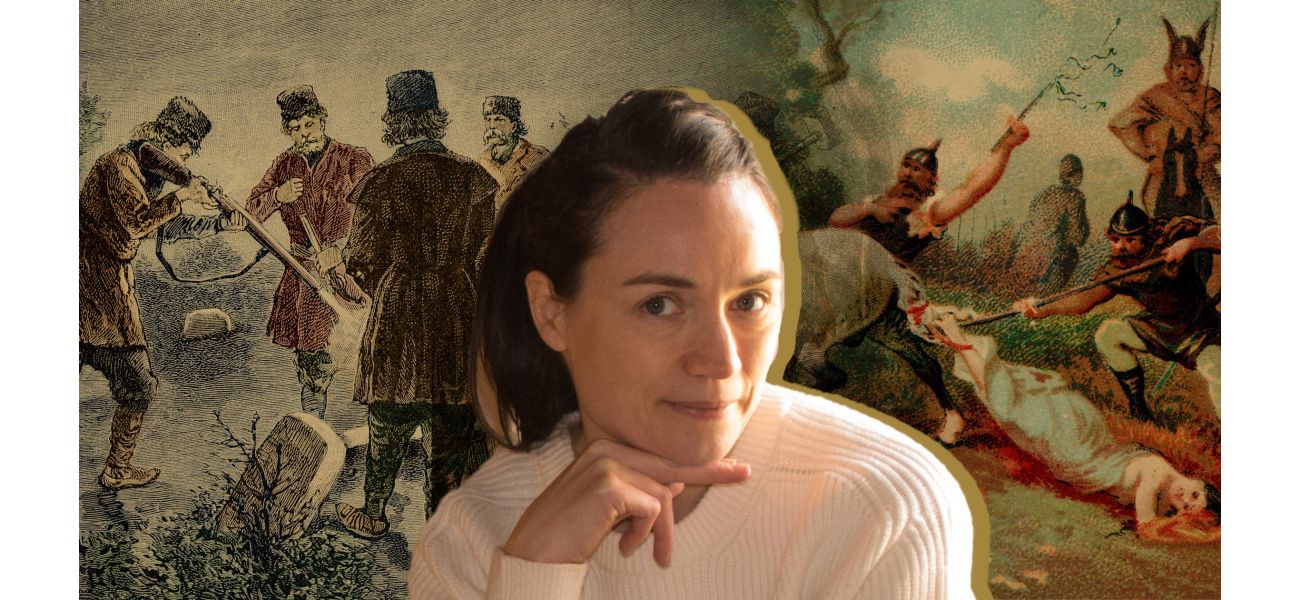A former detective aiding in the resolution of 400-year-old mysteries.
November 3rd 2024.

In the year 1699, a tragic incident occurred in Hertfordshire that left the entire community in shock. A young woman, Sarah Stout, was found dead in a river, her body floating face down without any of her outer garments. Sarah came from a wealthy family and had her whole life ahead of her, making her death all the more perplexing. Even the most experienced investigators were unable to make sense of the situation. Sarah had no known enemies or illnesses, so it was difficult to determine what could have caused her to drown in those cold, murky waters.
Blessin Adams, a former detective turned historian, shared with Metro the various conspiracy theories that were flying around at the time. Some believed that Sarah was pregnant and, as she had no husband, she took her own life to avoid the shame that would have befallen her and her family. However, with the emergence of forensic science, Sarah's death was eventually solved, along with other notable cases. It's worth noting that this was all done without the modern scientific advancements that we have at our disposal today. There were no fingerprinting techniques, recording equipment, or DNA tests to rely on.
Blessin explained that during that time, all deaths were investigated by coroners, many of whom had no medical or legal training. They were essentially just "flying by the seat of their pants." However, Sarah's case marked a significant shift as it was the first time that experts outside of the church were brought in to give their verdict on what had happened to her. But where did the answers lie? Well, in some rather unconventional methods, such as throwing dogs off bridges and submerging baby lungs in water.
The case of drownings was a particularly complex one. The last person to see Sarah alive was a 29-year-old lawyer named Spencer Cowper, who was a good friend of her family. He had been alone with her for about five hours, and naturally, all eyes were on him as Sarah's family accused him of her murder. Despite the coroner ruling her death as a suicide, her parents, who were Quakers, were unable to accept this and had her body exhumed for a private autopsy. This was a significant moment as it was the first time that expert witnesses were called in to give their opinions on the cause of death.
To determine whether someone had drowned or not, some rather unfortunate dogs were rounded up and drowned to see if they would sink or float. Blessin admits that this is quite cringeworthy to read about, but it was a form of forensic science that they were just trying to prove or disprove. However, even with this method, Spencer Cowper was able to convince the judge and jury that Sarah had taken her own life due to her unrequited love for him.
Infanticide was another issue that investigators struggled with during this time. Blessin's research led her to the case of Elizabeth Balleans, who, at the age of 18, found employment as a domestic worker for a man named Samuel Samlin. As Blessin explains, this was how she stumbled upon her area of expertise, the early modern period. Elizabeth was raped by Samlin, and within three months, she became pregnant. As an unmarried woman, this would have brought shame and disgrace upon her, and she was cast out by her employer and abuser.
Thankfully, Elizabeth's mother and sister took her in, and together, they were able to keep her pregnancy a secret until she delivered a stillborn baby boy. To determine whether the baby had died before or after birth, a new experiment called the "lung floatation test" was conducted. This test involved examining the lungs of the infant, which would be heavy and dark if they had died before birth, and lighter and able to float if they had died after birth. In Elizabeth's case, the lungs sank, and although this test was flawed, it ultimately spared her from the hangman's noose.
Sadly, suicide was considered one of the worst crimes a person could commit during this time. Blessin shares that it was not even written in statute, yet those who were suspected of taking their own lives were treated with contempt. Their bodies would be stripped, dragged through the streets, and buried in an unofficial grave with a spear piercing the ground to signify that a person who had died by suicide was buried there. However, investigators were able to differentiate between suicides and murders staged to look like suicides.
One such case was that of Richard Hunne, who was arrested and accused of heresy in 1514. He was found hanging in his cell, but the coroner suspected foul play. Blessin explains that public hangings were a common occurrence during that time, and the coroner was able to see that the evidence suggested that it was not a suicide. The color of Richard's skin and the state of his hair were both unusual for someone who had died by hanging. After further investigation, it was determined that Richard had been murdered by church officials while in a torture cell. However, due to the influence of the clergy and King Henry VIII, no one was held accountable for his death.
Sexual assault cases were almost impossible to prosecute during this time, and they were not taken as seriously as they should have been. One such example is that of Mary Hobry, a French midwife living in London, who was brutally assaulted by her husband Denis. After enduring years of abuse and violence, Mary finally snapped and killed her husband before dismembering his body parts and scattering them around the village. Sadly, her trial did not take into account the years of abuse she had suffered, and she was labeled a "monster" rather than a victim. This highlights the harsh reality that women during this time were expected to endure any mistreatment from their husbands, and it was not even a crime for a man to rape his own wife. Mary was ultimately burned at the stake, but her story serves as a reminder of the progress that has been made in the fight against sexual assault and domestic violence.
Blessin Adams, a former detective turned historian, shared with Metro the various conspiracy theories that were flying around at the time. Some believed that Sarah was pregnant and, as she had no husband, she took her own life to avoid the shame that would have befallen her and her family. However, with the emergence of forensic science, Sarah's death was eventually solved, along with other notable cases. It's worth noting that this was all done without the modern scientific advancements that we have at our disposal today. There were no fingerprinting techniques, recording equipment, or DNA tests to rely on.
Blessin explained that during that time, all deaths were investigated by coroners, many of whom had no medical or legal training. They were essentially just "flying by the seat of their pants." However, Sarah's case marked a significant shift as it was the first time that experts outside of the church were brought in to give their verdict on what had happened to her. But where did the answers lie? Well, in some rather unconventional methods, such as throwing dogs off bridges and submerging baby lungs in water.
The case of drownings was a particularly complex one. The last person to see Sarah alive was a 29-year-old lawyer named Spencer Cowper, who was a good friend of her family. He had been alone with her for about five hours, and naturally, all eyes were on him as Sarah's family accused him of her murder. Despite the coroner ruling her death as a suicide, her parents, who were Quakers, were unable to accept this and had her body exhumed for a private autopsy. This was a significant moment as it was the first time that expert witnesses were called in to give their opinions on the cause of death.
To determine whether someone had drowned or not, some rather unfortunate dogs were rounded up and drowned to see if they would sink or float. Blessin admits that this is quite cringeworthy to read about, but it was a form of forensic science that they were just trying to prove or disprove. However, even with this method, Spencer Cowper was able to convince the judge and jury that Sarah had taken her own life due to her unrequited love for him.
Infanticide was another issue that investigators struggled with during this time. Blessin's research led her to the case of Elizabeth Balleans, who, at the age of 18, found employment as a domestic worker for a man named Samuel Samlin. As Blessin explains, this was how she stumbled upon her area of expertise, the early modern period. Elizabeth was raped by Samlin, and within three months, she became pregnant. As an unmarried woman, this would have brought shame and disgrace upon her, and she was cast out by her employer and abuser.
Thankfully, Elizabeth's mother and sister took her in, and together, they were able to keep her pregnancy a secret until she delivered a stillborn baby boy. To determine whether the baby had died before or after birth, a new experiment called the "lung floatation test" was conducted. This test involved examining the lungs of the infant, which would be heavy and dark if they had died before birth, and lighter and able to float if they had died after birth. In Elizabeth's case, the lungs sank, and although this test was flawed, it ultimately spared her from the hangman's noose.
Sadly, suicide was considered one of the worst crimes a person could commit during this time. Blessin shares that it was not even written in statute, yet those who were suspected of taking their own lives were treated with contempt. Their bodies would be stripped, dragged through the streets, and buried in an unofficial grave with a spear piercing the ground to signify that a person who had died by suicide was buried there. However, investigators were able to differentiate between suicides and murders staged to look like suicides.
One such case was that of Richard Hunne, who was arrested and accused of heresy in 1514. He was found hanging in his cell, but the coroner suspected foul play. Blessin explains that public hangings were a common occurrence during that time, and the coroner was able to see that the evidence suggested that it was not a suicide. The color of Richard's skin and the state of his hair were both unusual for someone who had died by hanging. After further investigation, it was determined that Richard had been murdered by church officials while in a torture cell. However, due to the influence of the clergy and King Henry VIII, no one was held accountable for his death.
Sexual assault cases were almost impossible to prosecute during this time, and they were not taken as seriously as they should have been. One such example is that of Mary Hobry, a French midwife living in London, who was brutally assaulted by her husband Denis. After enduring years of abuse and violence, Mary finally snapped and killed her husband before dismembering his body parts and scattering them around the village. Sadly, her trial did not take into account the years of abuse she had suffered, and she was labeled a "monster" rather than a victim. This highlights the harsh reality that women during this time were expected to endure any mistreatment from their husbands, and it was not even a crime for a man to rape his own wife. Mary was ultimately burned at the stake, but her story serves as a reminder of the progress that has been made in the fight against sexual assault and domestic violence.
[This article has been trending online recently and has been generated with AI. Your feed is customized.]
[Generative AI is experimental.]
0
0
Submit Comment





